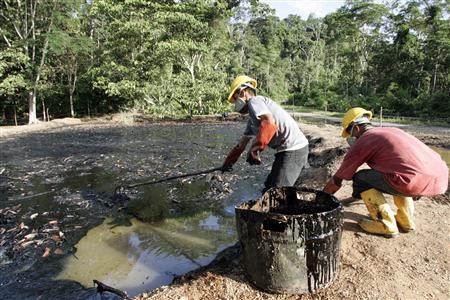Chevron Fights Potentially Historic Damages Case
Country: ECUADOR
Author: Hugh Bronstein

Ecuadorean oil workers clean up a contaminated fuel pool in this
file photo taken December 10, 2007.
Photo: REUTERS/Guillermo Granja/Files
A run-down court building that also houses the local casino in this Amazon jungle town is the unlikely venue for the largest environmental damages lawsuit ever tried.
On the first floor, people play for pennies in The Mirage bingo and slot machine parlor. Three stories up, in Sucumbios provincial court, the stakes are $27 billion.
That's what local farmers and indigenous tribes want from U.S. oil giant Chevron Corp to fund cleanup of areas they say were polluted with faulty drilling practices in the 1970s and '80s.
The paint is cracked and peeling in the judge's fourth-storey offices overlooking Lago Agrio, a poor and violent northern Ecuador town near the Colombian border.
Power failures often stop the building's air conditioners, leaving gamblers and court officials to swelter as judge Leonardo Ordonez pours through thousands of pages of evidence. He says a verdict could be reached in 2011 after 18 years of litigation in U.S. and Ecuadorean courts.
As the ruling looms, each side accuses the other of presenting fraudulent evidence while a slew of related legal actions are played out in the United States and Europe.
Investors and the petroleum industry are watching to see if Chevron will have to pay massive damages, setting a precedent that could fuel other big lawsuits against oil companies accused of polluting countries around the world.
Ecuador's President Rafael Correa has sided publicly with the plaintiffs. Both sides expect Ordonez to rule against Chevron. The company -- charging government interference in the case -- vows to appeal any adverse decision.
Plaintiffs say Texaco wrecked wide areas of Ecuador's jungle by dumping drilling waste into unlined pits and leaving them to fester, an accusation that the company denies.
Chevron inherited the case when it bought Texaco in 2001. It says the company cleaned up all pits it was responsible for before turning them over to Ecuador's state-owned oil firm, Petroecuador, which still operates around Lago Agrio.
"If there is pollution in this area, it is the sole responsibility of the state, which in 1998 released Texaco of further liability," said Chevron spokesman James Craig, pointing toward one of the waste pools cleaned up by Texaco.
Texaco built and operated more than 330 wells in Ecuador, all of which had at least one reserve pool nearby. The dirt just under the surface of some former waste pits still has a black sheen and carries the eye-watering stench of oil.
The suit names 46 people who claim to represent all area residents who may have suffered from contamination. They are not seeking individual awards but money to fund environment cleanup, as well as health and clean water projects.
"We want the money to go toward a permanent solution," said Carmen Perez, whose small corn farm is near a series of drilling waste pits that still smell of petroleum and, she says, cause her to have chronic headaches.
AMAZON CHERNOBYL?
Analysts say the case could have wide implications.
"If Chevron loses this case, it could set a precedent for similar cases in other countries against not only Chevron but other international oil companies" said Fadel Gheit, managing direct of oil and gas research at Oppenheimer & Co.
"It could open the floodgates for similar claims, starting in Nigeria where Royal Dutch Shell is being blamed for environmental damage," he said from his office in New York.
The Ecuador legal saga began in 1993 when a suit was filed against Texaco in a U.S. federal court. The case was tossed out on appeal in 2002 on condition that Texaco agree to Ecuadorean jurisdiction if sued there. A suit was filed in Lago Agrio the next year, this time against Texaco's new owner Chevron.
About 200,000 pages of documents and 64,000 chemical samples are in evidence while the intrigues of the case have come to resemble something from a Hollywood suspense drama.
A previous judge stepped down from hearing the suit last year after he was recorded discussing the case with a couple of shadowy figures who secretly video-taped him with cameras stuck inside a wristwatch and a pen.
One of the two men who taped the meeting, a former Chevron contractor, was whisked out of Ecuador by the company. The plaintiffs say the secret taping was an attempt by Chevron to delay judgment, a charge the company denies.
A cottage industry has meanwhile sprung up around the case, with plaintiffs providing reporters with thick folders full of information pointing the finger at Texaco/Chevron for what they call the "Chernobyl of the Amazon". They offer excursions to Ecuador's northern jungles known as "the toxic tour".
Chevron also arranges trips for journalists, dubbed "the non-toxic tour", showing pits that were cleaned up by Texaco. The company offers slickly-produced desk guides describing the suit as based on false claims driven by lawyers motivated more by greed than concern for the environment.
But the environment is certainly the top worry for farmer Jose Briceno, who lives near Lago Agrio and says he can't keep livestock because it gets sick and dies.
"The problem now is water quality," he said, looking over his empty farmyard. "They never really cleaned up this area."
(Editing by Kieran Murray)